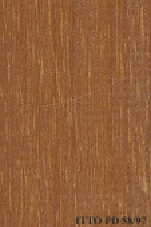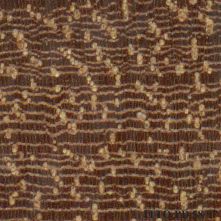
CONGOTALI (Letestua durissima)
Trade Name
Congotali
Scientific Name
Letestua durissima H.Lec.
Family
SAPOTACEAE
Common Names
Kong-Afane (Gabon); Congotali (Congo)
Scientific Name Synonyms
Pierreodendron durissimum A. Chev; Pierreodendron durissimum A. Chev.; Letestua floribunda Lecomte
Description Of The Tree
Botanical Description
The tree reaches a height of 40 to 50 m, with trunk diameter from 130 up to 200 cm. The bole is usually straight, cylindrical and high, with a fluted base.
Natural Habitat
Letestua durissima prefers rain forests.
Natural Distribution
This species occurs frequently in southern Gabon and only rarely in other areas.
Wood Identification
Anatomic Description Of Wood
Occasionally vessels in diagonal and/or radial pattern. Occasionally vessels exclusively solitary (over 90%). Tangential diameter of vessel lumina 100 to 150 micras (small). Tyloses thin walled. Tyloses common. Non-vestured pits. Vessels per mm2 6 to 10 (medium Axial parenchyma in continuous tangential lines or fine bands. Prismatic crystals in short chains in chambered axial parenchyma cells. Over 9 cells per parenchyma strand. Axial parenchyma in narrow bands on lines up to 3 cells wide. Axial parenchyma bands ove 4 to 10 rays per mm (medium). Rays non-storied. Rays commonly 2 seriate. Silica bodies in the ray cells. Heterogeneous rays and/or multiseriate heterogeneous rays. Non-septate fibers. Fibers with simple to minutely bordered pits.
-
 Wood Macro Photo Radial Plane
Wood Macro Photo Radial Plane
-
 Wood Micro Photo Of Transversal Section
Wood Micro Photo Of Transversal Section
Availability
Cites Status
Unrestricted
General Wood Description
Color
The sapwood is pale brown, it has a thickness of 5 to 8 cm. The heartwood is reddish brown to brown, it is clearly demarcated. The silver figure is fine (barely visible).
COLOR INDEX (1=Black, 7=Light yellow,white)
4
Grain
The grain is highly and systematically interlocked; special care is needed when drying because of frequent risks of distortion.
Texture
The wood is frequently reported to be fine textured.
Luster
Timber of this species is low in luster.
Natural Durability
Very durable to decay; without preservative treatment. This species is especially suited for all the uses with risks of permanent or long-lasting humidification. Resistant to termites attack. Heartwood is resistant to Lyctus attacks.
Natural durability index (1= Very high durability, 7=Vey low durability)
1
Internal Growth Stresses
Residual growth stresses are absent.
Silica Content
Silica Content: Presence of silica is reported in timber of this species. Amounts over 0.05% may affect the wood processing. Silica Value: 0.18
Resistance To Impregnation
Nearly impossible to treat with a too much low penetration of the preservative substances.
Wood Physical Properties
Basic Density or Specific Gravity (O.D. weight/vol. green) (g/cm³)
0.94
Air-dry Density (Weight and volume at 12%MC) (g/cm³)
1.10
Total shrinkage Tangential (Saturated to 0%MC) (%)
10.8
Total shrinkage Radial (Saturated to 0%MC) (%)
7.8
Drying Defects
Ease of Drying: Drying is moderately easy; some particular care is needed. Drying Defects: Risks of distortions when interlocked grain is present. Kiln Schedules: The kiln schedule has been tested.
Recommended Dry Kiln Schedule
FR-13
Dimensional stability ratio (Total Tangential Shrinkage %/Total Radial Shrinkage %)
1.4
Wood Chemical Properties
Wood Mechanical Properties
Bending Strength (MOR),12%MC (kgf/cm²)
1933
Stiffness (MOE) 12%MC (kgf/cm²)
272177
Compression parallel to fiber 12%MC (kgf/cm²)
942
Compression perpendicular to fiber 12%MC (kgf/cm²)
145
Shear strength radial 12%MC (kgf/cm²)
130
Janka hardness (side) 12%MC (kgf)
1525
Janka hardness (end grain) 12%MC (kgf)
1463
Workability
Sawing
Sawing of this species requires powerful equipment.
Rotary Veneer Cutting
Not suitable for veneering.
Sliced Veneer
Not suitable for veneering.
Blunting Effect
Severe blunting effect; stellited blades for sawing and carbide tools for machining are recommended.
Machining
It needs powerful tools for processing. Possible difficulties caused by interlocked grain are reported. It is recommended to use special tools for cutting.
Planing
Rather difficult; special tools are needed.
Moulding
Moderately easy; tools must be cautiously sharpened.
Boring
Moderately easy; tools must be cautiously sharpened.
Mortising
Moderately easy; tools must be cautiously sharpened.
Nailing
Pre-boring is necessary.
Gluing
Difficult to glue because of high density.
Sanding
Difficult to obtain very good results because of interlocked grain.
Polishing
Can be polished without surface preparation.
Response To Hand Tools
Working with hand tools is difficult.
REFERENCED USES
End Uses Summary
EXTERIOR GENERAL, bridges, rails, crossarms, crossties, piers, HOUSING GENERAL, beams, joists, boards, flooring, parquet, frames, CONTAINERS, truck bodies, truck flooring
Exterior General
- 1 - Tabela de resultados de ensaios fisicos e mecanicos
Bridges
- 2 - 25 madeiras da amazonia de valor comercial, caracterizacao, macroscopica, usos comuns e indices qualificativos
Rails
- 6 - Physical and mechanical properties of Eucalyptus deglupta Blume grown in Costa Rica
Crossheads Crossarms
- 7 - Maderas latinoamericanas. II, Quercus alata Q. costaricensis y Q. eugeniaefolia
Crossties
- 8 - Maderas latinoamericas. III, Podocarpus standleyi ,Podocarpus oleifolius, Drims granadensis, Magnolia poasana y Didymopanax pittieri
Piers
- 9 - Maderas latinoamericanas. IV, Nectandra sp. Ocotea austinii, Persea sp. aff. vesticula, Persea schiedeana
General Housing
- 10 - Silica in Timbers
Beams
- 11 - Prospect: The wood database
Joists
- 12 - Tropical timbers of the world. Part I-Tropical American Species
Boards
- 13 - Dry kiln schedules for commercial woods. Temperate and tropical. Section III. Latin American (Mexico, Central, and South America) Woods–Conventional Temperatures
Flooring
- 14 - Handbook of Hardwoods
Parquet
- 15 - Empire Timbers
Frames
- 16 - Woods of the World
Truck Body
- 53 - Timbers of the New World
Truck Flooring
- 54 - Bulletin of the Government Forest Experiment Station N.157: Identification of Tropical Woods
Please Provide Information To View Producer Information